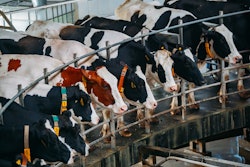
As demand for alternatives to conventional meat production grows, lab-grown meat has emerged as a solution. It is proposed that cultured meat offers the possibility of producing an alternative to real animal meat without the environmental and ethical concerns often tied by some interest groups to traditional livestock farming.
Regardless of our beliefs or preferences, it remains a reality posed to affect our industry and, as such, we ought to understand it better. To do so, we need to first explore the science behind lab-grown meat, the biological techniques involved, the composition of nutrients and bio-factors used, and some of the challenges and uncertainties that need to be addressed.
How lab-grown meat is made
Lab-grown meat, also known as cultured or cell-based meat, is produced by cultivating real animal cells in a controlled environment, outside of the animal’s body. The process begins by isolating muscle stem cells from an animal. These cells are placed in a nutrient-rich medium inside a bioreactor, which mimics the conditions within a living animal, promoting cell division and tissue growth. Over time, the cells proliferate and form a tissue mimicking real muscle, which is then harvested and processed into edible meat-like products.
This process is distinct from plant-based meats, which use plant proteins to mimic meat. Lab-grown meat uses real animal cells, and some suggest it provides a closer match in terms of taste and texture to real meat.
Key biological techniques in cultured-meat production
Several advanced biological techniques are involved in creating lab-grown meat:
- Cell isolation: Stem cells or muscle cells are extracted from an animal, typically using a biopsy. These cells have the potential to multiply and form new tissue.
- Cell culture: Once isolated, the cells are placed in a nutrient-rich medium that supports their growth. This medium provides the necessary energy and building blocks for cell multiplication.
- Tissue scaffolding: To form structured tissue, cells are often grown on a scaffold, which provides a 3D framework that mimics the extracellular matrix in natural tissue. The scaffold guides the cells as they grow and ensures that the tissue forms in a way that resembles real muscle fibers. Edible materials such as collagen or plant fibers are typically used for scaffolding, ensuring the final product is safe for consumption.
- Bioreactor use: A bioreactor is a specialized device that provides a controlled environment for cell growth. It regulates factors including temperature, oxygen and nutrient supply, optimizing conditions for cell proliferation and tissue formation.
- Differentiation: Through precise control of growth conditions and the use of specific growth factors, cells are guided to mature into muscle, fat or connective tissue, depending on the desired final product.
Nutrients in the bioreactor: feeding the cells
For cells to thrive and grow into tissue, they must be provided with a nutrient-dense medium. The bioreactor serves as the growth environment, and the medium contains the following key nutrients:
- Amino acids: These are the building blocks of proteins, essential for muscle cell growth and repair
- Glucose: A primary energy source that fuels cellular processes.
- Vitamins: All necessary vitamins, including B vitamins, necessary for metabolic activity.
- Minerals: Essential minerals such as calcium, potassium and magnesium that support various cellular functions and tissue formation.
- Fats: For cellular structure, energy and tissue integrity.
- Growth factors: Specialized proteins or hormones that trigger cell growth, division and differentiation.
The role of growth factors in lab-grown meat
Growth factors are vital in cultured meat production as they signal the cells to multiply and mature into muscle tissue. The most commonly used growth factors include:
- Fibroblast growth factor (FGF): Promotes the growth and repair of tissues.
- Insulin-like growth factor (IGF): Encourages cell proliferation and protein synthesis, helping cells to grow and multiply.
- Transforming growth factor-beta (TGF-β): Aids in cell differentiation, guiding cells to mature into specific tissue types.
- Epidermal growth factor (EGF): Stimulates cell growth and division, accelerating tissue development.
Traditionally, growth factors were derived from animal sources, such as fetal bovine serum (FBS). However, the industry wants to move away from this approach to adopt more scalable methods. Today, many companies use recombinant proteins, produced through genetic engineering in microorganisms like yeast or bacteria. Synthetic peptides, which mimic natural growth factors, are also being explored as alternatives.
Edibility of tissue scaffolding: addressing purity concerns
A common question surrounding lab-grown meat is whether it is 100% meat components. The short answer is no — it is not completely pure muscle tissue, as it contains minor components such as scaffolding and residual growth medium components. However, the scaffolds used in production are edible and biodegradable, typically made from materials such as collagen or plant-based polymers. These components are safe for consumption and designed to replicate the texture and structure of real meat as closely as possible.
The percentage of non-meat-alike components, including the scaffolding and residual growth factors, is typically very low — usually 1% to 5%. This ensures that lab-grown meat closely mimics the taste, texture and nutritional profile of conventional meat. Or, at least this is the goal because this is still a work in progress.
Challenges and negative issues with lab-grown meat
While lab-grown meat has potential according to its advocates, there are still significant challenges and uncertainties to overcome, again according to its own advocates:
- Cost: Lab-grown meat remains expensive to produce. The bioreactors, growth factors, and cell culture media add considerable costs, making it difficult for lab-grown meat to compete with real meat in terms of price. Scaling production and developing cost-effective alternatives to expensive components, like growth factors, are key areas of ongoing research.
- Energy use: Culturing meat in bioreactors requires energy for maintaining optimal growth conditions, including temperature, oxygen levels and mixing. Depending on the source of this energy, lab-grown meat could have a significant carbon footprint. This is speculative, as studies on the environmental impact of lab-grown meat are ongoing, and results vary based on the energy sources used.
- Nutritional profile: While lab-grown meat is expected to closely mimic the taste and texture of real meat, its nutritional profile may differ. For example, lab-grown meat might lack certain micronutrients naturally found in raised animals, such as iron and vitamin B12, unless they are specifically added during production. This is an educated guess, as the final nutritional profile could vary depending on the production techniques used.
- Consumer acceptance: Despite the proclaimed potential benefits, consumers may have reservations about lab-grown meat, viewing it as unnatural or overly processed. Overcoming such public skepticism will require clear communication about the safety, sustainability and perceived ethical features of cultured meat. This is speculative, as consumer attitudes toward lab-grown meat may evolve unpredictably.
- Regulatory hurdles: The regulatory framework for cultured meat is still evolving. Ensuring safety and quality control will require robust standards and testing, and it may take time for governments worldwide to develop consistent regulations. This could delay broader adoption, an assumption based on the current regulatory landscape, though exact timelines will vary by region and country.
- The future of animal farmers: If lab-grown meat advances, one critical question arises: What will happen to existing animal farmers? The shift toward cultured meat could profoundly affect the livestock industry, rural communities and the livelihood of an enormous number of people indirectly attached to the animal industry. Shifting their business into a niche-market model is rather utopistic when we are discussing an industry that refers to a major human food staple, such as meat.
In summary, although lab-grown meat might be another niche-market adventure, like plant-based meat alternatives, it is best to be prepared to discuss this with any interested party.














